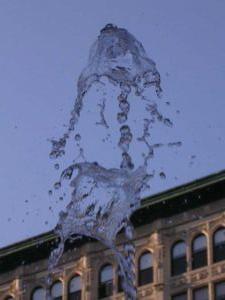
Are you interested in learning how to take pictures of moving water that are both interesting and illustrate good photography skills? Read on to find out how.
What Makes Moving Water Difficult?
Learning how to take pictures of moving water can be a challenge for three reasons:
- As with all types of action photography, moving water is quick and unpredictable. Even if you are shooting a water source that continues to run in a predictable manner, such as a water foundation, you cannot predict where the water will splash.
- If you are trying to stop the action of moving water, it can often take a lot of manipulating of settings in order to find the best shutter speed, lens, aperture setting, etc.
- If you are trying to capture the motion of the water, it can be difficult to make it look intentional. Often with shots of moving water, the water will look blurred. It is sometimes difficult to make this look like the photographer's intention and not the photographer's lack of camera control.
Common Types of Moving Water Photographs
Some common types of moving water sources include:
- Water fountains
- Water statues
- Waterfalls
- Water faucets
- Rain
- Streams
- Showers
How To Take Pictures of Moving Water
Here are some helpful tips for taking photographs of moving water sources:
Camera Settings
Perhaps one of the most important elements in taking photos of moving objects is your personal camera settings. If you know your cameras settings, it is easier to change the settings quickly. Even a point-and-shoot digital camera can take great pictures of moving water when the settings are used properly.
If you have a DSLR or a SLR, try to use the quickest shutter speeds and widest aperture settings for moving water. This will allow you to freeze the water. If you are interested in showing a more blurred image of the water in motion, use a slower shutter speed, but keep your aperture wide. When shooting water, using a flash is not recommended. Water provides too much reflection. However, a wide aperture will let in the greatest amount of light.
If you are using a film or digital point-and-shoot camera, use the camera's sports setting. If the device does not have this setting or something similar to it, then turn off the flash. It may be harder but you can still get a great picture of moving water by doing so.
Experimentation
Moving water is a very fickle subject. This is why it is important to be willing to experiment with different shooting methods. Sometimes you will find that you have one idea in mind but that another will work out better. For example, you may be interested in freezing a droplet of water in midair but discover that blurring it may look much better. Play around with what is given to you.
Angles and Lighting
Part of experimenting is being willing to move. This is especially important when shooting moving water. You can increase your chances of capturing a great shot by moving around. For example, if you are shooting a running hose in summer, moving closer or further away from the hose may give you a better shot. Perhaps there is an angle where you can capture the sun in the background for more light in the shot. There are always options in your camera's viewfinder if you look for them.
Examples


Blurred moving water versus frozen in time moving water
Conclusion
Though moving water can be a difficult subject to photograph, it can also be one of the most fulfilling for a photographer. When done right, moving water pictures are often popular and elegant. Keep working for the perfect shot and you are bound to come across a water photograph that makes you proud of yourself.







